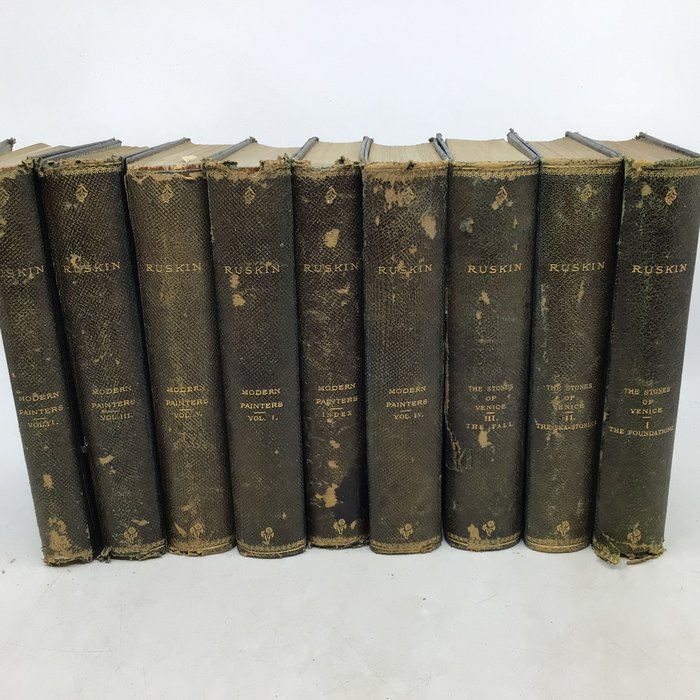
John Buchan - Collection of Works (Blanket of the Dark, Prince of the Captivity, Free Fishers, Book of Escapes, - 1930
Nro. 83094333

Nro. 83094333

"The Work of John Ruskin" by John Ruskin - George Allen, London - 1898 edition (the Modern Painters 1-5 plus add. volume, second edition in small form; the stones of venice 1-3, new edition in small form) - 15cmx13cm - condition: good, reboun in deluxe limp leather binding with rubbing and wear to boards and spines, ill. and frontispieces when issued are present, gift inscription to W.J White present from the members and friends of the Kilburn Young Men's Assoc)
John Ruskin (8 February 1819 – 20 January 1900) was an English writer, philosopher, art historian, art critic and polymath of the Victorian era. He wrote on subjects as varied as geology, architecture, myth, ornithology, literature, education, botany and political economy.
Ruskin was heavily engaged by the work of Viollet le Duc which he taught to all his pupils including William Morris, notably Viollet le Duc's Dictionary which he considered as "the only book of any value on architecture".[1]
Ruskin's writing styles and literary forms were equally varied. He wrote essays and treatises, poetry and lectures, travel guides and manuals, letters and even a fairy tale. He also made detailed sketches and paintings of rocks, plants, birds, landscapes, architectural structures and ornamentation. The elaborate style that characterised his earliest writing on art gave way in time to plainer language designed to communicate his ideas more effectively. In all of his writing, he emphasised the connections between nature, art and society.
Ruskin was hugely influential in the latter half of the 19th century and up to the First World War. After a period of relative decline, his reputation has steadily improved since the 1960s with the publication of numerous academic studies of his work. Today, his ideas and concerns are widely recognised as having anticipated interest in environmentalism, sustainability and craft.
Ruskin first came to widespread attention with the first volume of Modern Painters (1843), an extended essay in defence of the work of J. M. W. Turner in which he argued that the principal role of the artist is "truth to nature". From the 1850s, he championed the Pre-Raphaelites, who were influenced by his ideas. His work increasingly focused on social and political issues. Unto This Last (1860, 1862) marked the shift in emphasis. In 1869, Ruskin became the first Slade Professor of Fine Art at the University of Oxford, where he established the Ruskin School of Drawing. In 1871, he began his monthly "letters to the workmen and labourers of Great Britain", published under the title Fors Clavigera (1871–1884). In the course of this complex and deeply personal work, he developed the principles underlying his ideal society. As a result, he founded the Guild of St George, an organisation that endures today.
Näin ostat Catawikistä
1. Löydä jotain erityistä
2. Tee korkein tarjous
3. Maksa turvallisesti